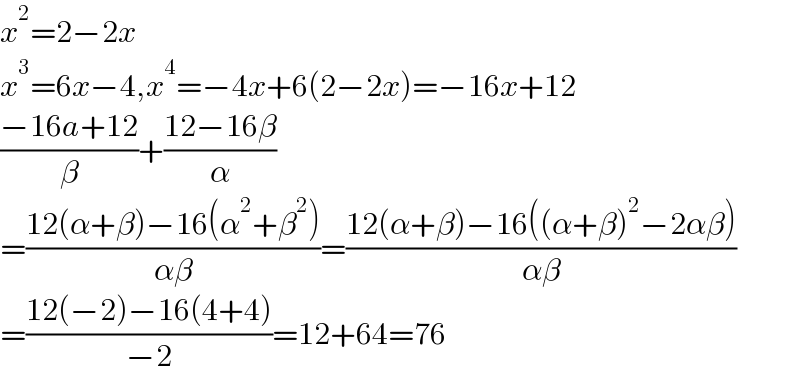
Question and Answers Forum
Question Number 162533 by mnjuly1970 last updated on 30/Dec/21

Answered by Ar Brandon last updated on 30/Dec/21
![x^2 +2x−2=0 α+β=−2 αβ=−2 (α^4 /β)+(β^4 /α)=((α^5 +β^5 )/(αβ))=((−152)/(−2))=76 (α+β)^5 =α^5 +5α^4 β+10α^3 β^2 +10α^2 β^3 +5αβ^4 +β^5 α^5 +β^5 =(α+β)^5 −5αβ(α^3 +β^3 )−10α^2 β^2 (α+β) =(α+β)^5 −5αβ(α+β)[(α+β)^2 −3αβ]−10α^2 β^2 (α+β) =(−2)^5 −5(−2)(−2)[(−2)^2 −3(−2)]−10(−2)^2 (−2) =−32−20(10)+80=80−32−200=−152 1.1 1.2.1 1.3.3.1 1.4.6.4.1 1.5.10.10.5.1](Q162536.png)
Commented by mnjuly1970 last updated on 30/Dec/21

Answered by Rasheed.Sindhi last updated on 30/Dec/21

Commented by JDamian last updated on 30/Dec/21
Mr. Rasheed: -16-(-2)(-2) = -20
Commented by Rasheed.Sindhi last updated on 30/Dec/21

Answered by Rasheed.Sindhi last updated on 30/Dec/21

Commented by Rasheed.Sindhi last updated on 30/Dec/21

Commented by mr W last updated on 30/Dec/21
����������
Commented by mnjuly1970 last updated on 30/Dec/21

Answered by bobhans last updated on 30/Dec/21

Commented by mnjuly1970 last updated on 30/Dec/21

Answered by mindispower last updated on 30/Dec/21

Commented by Rasheed.Sindhi last updated on 31/Dec/21

Commented by tounghoungko last updated on 31/Dec/21

Commented by Rasheed.Sindhi last updated on 31/Dec/21

Commented by mr W last updated on 31/Dec/21

Commented by Rasheed.Sindhi last updated on 31/Dec/21

Commented by mindispower last updated on 31/Dec/21

Commented by Rasheed.Sindhi last updated on 31/Dec/21

Commented by mindispower last updated on 31/Dec/21

Commented by Rasheed.Sindhi last updated on 31/Dec/21
������
